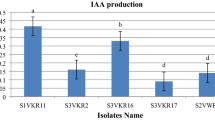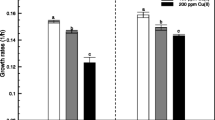Abstract
Mesorhizobium strain RC3, isolated from chickpea nodules, tolerated chromium up to 500 μg/ml and reduced it by 90% at pH 7 after 120 h. It produced plant growth-promoting substances, both in the presence and absence of chromium. Strain RC3 produced 35 μg indole acetic acid/ml in Luria Bertani broth with 100 mg tryptophan/ml, which decreased with an increase in chromium concentration. Chromium application to soil at 136 mg/kg was toxic to chickpea plants but when RC3 at 136 mg/kg was also added, it increased the dry matter accumulation, number of nodules, seed yield and grain protein by 71, 86, 36 and 16%, respectively, compared to non-inoculated plants. Nitrogen in roots and shoots were increased by 46 and 40%, respectively, at 136 mg Cr/kg. The bio-inoculant decreased the uptake of chromium by 14, 34 and 29% in roots, shoots and grains, respectively.
Similar content being viewed by others
Explore related subjects
Discover the latest articles, news and stories from top researchers in related subjects.Avoid common mistakes on your manuscript.
Introduction
Chromium is often discharged into the environment from electroplating, pigment production and leather tanning industries. It affects soil microbial activity and soil fertility, resulting in losses in yield of plants. Chromium occurs mainly in trivalent and hexavalent forms and is actively transported to the cells (Ortegel et al. 2002). Chromium(VI) is more toxic than Cr(III) and produces mutagenic and carcinogenic effects (McLean and Beveridge 2001). Unlike organic pollutants, metals cannot be degraded and therefore, persist in the environment. Reduction of Cr(VI) to Cr(III) leads to its detoxification. Conventional methods to alleviate the toxicity of chromium include its chemical reduction followed by precipitation, ion exchange and adsorption on activated coal, alum or ash. Most of these methods require high energy or large quantities of chemicals. The reduction of Cr(VI) by microbes is, however, a viable and cost-effective option. Chromium-resistant microorganisms reduce Cr(VI) either enzymatically or non-enzymatically. Among these microbes, nodule bacteria can protect the plants against the toxic effects of chromium through adsorption/desorption mechanisms. However, little information is available on the role of chromate-resistant rhizobia on chickpea growth. Moreover, to the best of our knowledge, there is no report on the effect of chromium on the growth-promoting potentials of the nodule bacteria. The present study was, therefore, designed to determine the plant growth-promoting activity, in the presence and absence of Cr(VI), and the bioremediation potential of chromium-reducing Mesorhizobium RC3, using chickpea (Cicer arietinum L.) as a test crop.
Materials and methods
Rhizobial strains and evaluation of chromium tolerance
Mesorhizobium strains were isolated from chickpea nodules and were characterized. The strains were tested for resistance to Cr(VI) by dilution method using yeast extract/mannitol/agar (YEMA) medium. In a plate dilution method, agar plates, amended with K2Cr2O7, at 50–500 μg/ml, were inoculated with 48 h-grown cultures and incubated at 28 ± 2°C for 72 h. The lowest concentration of Cr(VI) inhibiting growth on YEMA plates was defined as minimum inhibitory concentration.
Growth and chromium reduction
The culture flasks containing YEM broth, supplemented with 50, 100 and 150 μg Cr(VI)/ml were inoculated with rhizobial isolates (≅108 cells/ml) and incubated for 120 h at 28 ± 2°C. Growth was determined at intervals. To assess the effect of pH on Cr(VI) reduction in vitro, the YEM broth was amended with 100 μg Cr/ml and the autoclaved medium was adjusted to pH 5–9 with 1 M HCl or 1 M NaOH and incubated at 28 ± 2°C for 120 h. For reduction of Cr(VI), one ml culture from each flask was centrifuged at 500g for 10 min at 10°C and Cr(VI) in the supernatant was determined (Eaton et al. 1992).
Effect of chromium on IAA and siderophore
Indole-3-acetic acid (IAA) was quantitatively assayed using Luria Bertani (LB) broth supplemented with Cr up to 150 μg/ml by the method of Brick et al. (1991). Siderophore production was qualitatively assayed by the Chrome Azurol S method (Alexander and Zuberer 1991). Catechol-type phenolates was quantitatively determined using Modi medium amended with Cr up to 150 μg/ml by the method of Reeves et al. (1983). For the assay, one volume of the Hathway’s reagent was added to one volume of sample, and absorbance was determined at 560 nm for salicylates with sodium salicylate as a standard and at 700 nm for dihydroxy phenols with 2,3 DHBA as a standard.
Plant growth and chromium uptake
Seeds of chickpea var. avrodhi were surface-sterilized and coated with strain RC3 by dipping the seeds in liquid culture medium for 2 h using 10% (w/v) gum arabic as adhesive to deliver 108 cells/seed. The inoculated and non-inoculated seeds were sown in pots with 3 kg unsterilized sandy clay loam soil (organic C 0.4%, N 0.75 g/kg, P 16 mg/kg, Cr 6.3 μg/g, pH 7.2 and WHC 0.44 ml/g) and Cr was added as indicated. Controls without chromium were also run. Six pots per treatment arranged in a complete randomized design were kept in open field conditions. All plants in three pots removed 90 days after sowing were used for dry matter production and nodulation. Nodules were dried at 80°C and weighed. Roots and shoots N were measured at 90 DAS by a micro-Kjeldahl method. Chromium in plant organs was measured by the method of Ouzounidou et al. (1992). Seed yield and grain protein was determined at 135 DAS. Data were subjected to ANOVA and difference among treatment means was compared using Tukey test. Data was also analyzed for two factor i.e. inoculation and Cr concentration, and LSD was calculated at 5% probability.
Result and discussion
Rhizobial strain and chromium tolerance
About 50 N2-fixing bacteria were isolated from chickpea nodules that grew on Cr-containing plates. Of these, strain RC3 tolerated chromium up to 500 μg/ml and was used for further studies. It was identified as Mesorhizobium by biochemical tests (Holt et al. 1994). A Pseudomonas strain CRB5 has been reported as tolerant to 500 μg Cr/ml (McLean et al. 2000) and a Bacillus sp. tolerant to 550 μg Cr/ml (Wani et al. 2007a, b).
Rhizobial growth and Cr(VI) reduction as influenced by pH and chromate concentration
Maximum rhizobial growth in YEM broth was with 50 μg Cr/ml after 48 h. Growth declined with higher concentrations of Cr(VI) (data not shown). Maximum reduction of Cr by strain RC3 was at pH 7 (Fig. 1). Reduction of Cr(VI) increased with increasing concentration of Cr (Fig. 2). Strain RC3 completely reduced 50 μg Cr/ml. Growth was decreased considerably in liquid medium compared to on solid medium for reasons that are not yet clear.
Production of plant growth-promoting substances under chromium stress
Strain RC3 produced IAA, both in the absence and presence of Cr, in LB broth, supplemented with tryptophan upto 100 mg/ml (Table 1). Strain RC3 showed siderophore activity, in the absence and presence of Cr. Strain RC3 produced a maximum amount of 2,3-DHBA (25 mg/l) at 50 μg Cr/ml. The plant growth-promoting substances did not differ significantly with the treatments, and were not adversely affected by Cr. Similar production of IAA and siderophores by chromium-reducing bacteria under Cr stress has been reported (Wani et al. 2007a, b).
Chickpea growth
Chickpea plants grew poorly when the soil was amended with Cr (Table 2). Chromium at 136 mg/kg significantly (P ≤ 0.05) decreased dry biomass, number of nodules, grain protein and other parameters compared to the control. Chromium at elevated levels inhibits the growth of plants (Zayad and Terry 2003) but, when strain RC3 at 136 mg/kg was also added, it increased the measured parameters (Table 2). The inoculant strain protected the plants from Cr toxicity possibly through the soluble chromate reductase or by providing plants with the sufficient amounts of growth-promoting substances. Chromium in roots (Fig. 3A) was higher than in shoots (Fig. 3B) and grains (Fig. 3C) both in the absence and presence of strain RC3. The inoculant strain reduced the Cr uptake by plant organs. Similarly, accumulation of Cd and Cr in greengram has been reported (Wani et al. 2007a, b). In conclusion, the strain RC3 showed a potential for Cr(VI) reduction, produced plant growth-promoting substances under Cr stress and enhanced the growth and yield of chickpea, both in Cr stress and Cr free conditions. Due to the multifarious activity, the strain RC3 could therefore, be utilized for growth promotion as well as for the bioremediation of Cr polluted soil. Molecular characterization of this strain is in progress.
References
Alexander DB, Zuberer DA (1991) Use of chrome azurol S reagents to evaluate siderophore production by rhizosphere bacteria. Biol Fertil Soils 12:39–45
Brick JM, Bostock RM, Silversone SE (1991) Rapid in situ assay for indole acetic acid production by bacteria immobilized on nitrocellulose membrane. Appl Environ Microbiol 57:535–538
Eaton AD, Clesceri LS, Greenberg AE (eds) (1992) Standard methods for the examination of water and wastewater. American Public Health Association; American Water Works Association (AWWA), Water Environment Federation (WEF), Washington DC, 981
Holt JG, Krieg NR, Sneath PHA, Staley JT, Willams ST (eds) (1994) Bergey’s manual of determinative bacteriology. Williams & Wilkins, Baltimore, USA
McLean J, Beveridge TJ (2001) Chromate reduction by Pseudomonad isolated from a site contaminated with chromated copper arsenate. Appl Environ Microbiol 67:1076–1084
McLean J, Beveridge TJ, Phipps D (2000) Isolation and characterization of a chromium reducing bacterium from a chromated copper arsenate contaminated site. Environ Microbiol 2:611–619
Ortegel JW, Staren ED, Faber LP, Warren WH, Braun DP (2002) Modulation of tumor-infiltrating lymphocyte cytolytic activity against human non-small cell lung cancer. Lung cancer 36:17–25
Ouzounidou GE, Eleftheriou P, Karataglis S (1992) Ecophysiological and ultrastructural effects of copper in Thlaspi ochroleucum (cruciferae). Can J Bot 70:947–957
Reeves MW, Pine L, Neilands JB, Balows A (1983) Absence of siderophore activity in Legionella species grown in iron-deficient media. J Bacteriol 154:324–329
Wani PA, Khan MS, Zaidi A (2007) Cadmium, chromium and copper in greengram plants. Agron Sustain Dev 27:145–153
Wani PA, Khan MS, Zaidi A (2007) Chromium reduction, plant growth promoting potentials and metal solubilization by Bacillus sp. isolated from alluvial soil. Curr Microbiol 54:237–243
Zayad A, Terry N (2003) Chromium in the environment: factors affecting biological remediation. Plant Soil 249:139–156
Author information
Authors and Affiliations
Corresponding author
Rights and permissions
About this article
Cite this article
Wani, P.A., Khan, M.S. & Zaidi, A. Chromium-reducing and plant growth-promoting Mesorhizobium improves chickpea growth in chromium-amended soil. Biotechnol Lett 30, 159–163 (2008). https://doi.org/10.1007/s10529-007-9515-2
Received:
Revised:
Accepted:
Published:
Issue Date:
DOI: https://doi.org/10.1007/s10529-007-9515-2







